Every company wants innovation to be a core value, but innovation doesn’t happen on its own.
That was the key takeaway of Kirstine Stewart’s talk at MaRS Verge in Toronto today, an event that attracted 175 people from 20 different sectors.
“Success needs to be praised, but failure also needs to be supported,” said Stewart. “If people don’t believe they can stick their neck out, they won’t.”
Kirstine Stewart is the chief strategy officer of Diply, a social news and content website. Prior to joining the London, ON-based company Stewart was VP of North American partnerships at Twitter.
“Somehow, we think of innovation as being scary and that we have to disrupt everything,” said Stewart.
Stewart believes that the key to taking fear out of innovation is building an environment of trust.
There can’t be fear of negative consequences if a project or initiative does not have a successful outcome. Failure has to be supported in order to build trust with employees.
“When I worked in the U.S. this was part of their culture I wish Canada had more of,” said Stewart.
Jon Worren, Senior Director of Entrepreneurship Programs at MaRS says culture is critical to making innovation successful.
“People often come to us because they think something’s not working in their company’s approach to innovation and it usually comes down to culture,” Worren told TechPORTFOLIO. “Many corporates recognize that startups have set the model in how to build an innovative company culture.”
What else helps make innovation possible in both startups and large enterprise?
Innovation comes from all employees — not just the IT department
“Innovation doesn’t have a look,” said Stewart. “It’s not about being Steve Jobs in a black turtleneck.”
Tech companies earn a lot of media coverage for being harbingers of innovation, but they can also struggle to scale with it.
“They’re often based on founder culture, and that doesn’t always scale” said Stewart. “Transformation from a startup to a larger company means founder culture needs to expand so everyone feels like a founder of the business.”
Companies that spread power across an employee base are more likely to be successful with innovation.
Innovation might require structural changes
While Stewart was at the CBC, reorganizing the broadcaster’s approach to digital was one of the ways innovation was supported.
The digital team had been siloed and functioned like a hub, rather than being part of everything the organization did. Stewart said the CBC had to dismantle this hub and enable a digital-first mentality across the organization and in every department.
This move fostered innovation.
“You have to empower people with responsibility,” said Stewart. “It has to be embedded into every area of the business and not classed as just an innovation project.”
Look outside, speak up, and manage up
“No matter what size company you’re at, you have to look outside yourself,” said Stewart.
In her time at CBC and Twitter Canada, Stewart learned you have to remind people — who are often talented and have been with a company for a long time — that the world is changing.
As an employee, you also have to speak up even when you think your organization won’t listen: it’s your responsibility to bring ideas forward.
To overcome organizational limitations, Stewart said you have to manage up. Put yourself in your boss’ shoes and think about what he or she has to consider, what the consequences are, and find ways to eliminate risk for them.
“Risk is a scary thing to be signed up for,” said Stewart. “Manage expectations as well as fear of others.”






















 /newsrooms
/newsrooms
